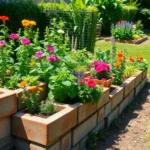Transform your cramped balcony into a thriving green oasis that’ll make your neighbors jealous. We’ve discovered that even the tiniest outdoor spaces can become stunning gardens with the right approach and creative ideas. Whether you’re dealing with a narrow fire escape or a spacious terrace we’ll show you how to maximize every square inch.
Urban living doesn’t mean sacrificing your green thumb dreams. Small-space gardening has exploded in popularity as more people realize they can grow fresh herbs vegetables and beautiful flowers right outside their door. We’ve tested countless balcony garden setups and found the most effective techniques that work regardless of your space limitations or gardening experience.
Ready to create your own slice of paradise? From vertical growing systems to space-saving planters we’ll guide you through practical answers that transform any balcony into a productive beautiful garden. Let’s jump into the best balcony garden ideas that actually work in real-industry situations.
Choose the Right Containers for Your Balcony Garden
Selecting appropriate containers forms the foundation of successful balcony gardening. We’ll explore three essential factors that determine which planters work best for your outdoor space.
Consider Size and Drainage Requirements
Container size directly impacts plant health and growth potential in balcony gardens. We recommend choosing pots that are at least 12 inches deep for vegetables like tomatoes and peppers, while herbs thrive in containers as shallow as 6 inches. Larger containers retain moisture longer and provide more root space, reducing the frequency of watering sessions.
Drainage holes prevent waterlogged soil that kills plant roots through oxygen deprivation. We suggest containers with multiple drainage holes spaced 2-3 inches apart across the bottom surface. Adding a layer of gravel or broken pottery pieces creates additional drainage while preventing soil from escaping through the holes.
Weight considerations become crucial when planning your balcony garden layout. Standard ceramic pots filled with soil can weigh 20-30 pounds each, potentially exceeding balcony weight limits. We calculate total weight by adding container weight, soil weight, and water weight to ensure structural safety.
Select Weather-Resistant Materials
Weather resistance determines container longevity in outdoor balcony environments. We prefer materials that withstand temperature fluctuations, UV exposure, and moisture without cracking or fading over time.
Fiberglass containers offer excellent durability while remaining lightweight for balcony use. These planters resist cracking in freezing temperatures and won’t fade under direct sunlight like some plastic alternatives. We’ve found high-quality fiberglass containers last 10-15 years with minimal maintenance.
Resin and composite materials provide weather resistance at budget-friendly prices. These containers mimic natural stone or wood appearances while offering superior weather protection. We recommend checking UV-resistance ratings when selecting resin planters for sunny balcony locations.
Ceramic and terra cotta require careful consideration in harsh climates. These natural materials add aesthetic appeal but may crack during freeze-thaw cycles. We suggest moving ceramic containers indoors during winter months or choosing frost-resistant glazed options.
Optimize Space with Vertical Planters
Vertical planting systems maximize growing space in compact balcony gardens. We use wall-mounted planters, tiered stands, and hanging containers to create multiple growing levels within limited square footage.
Pocket planters transform blank walls into productive growing surfaces. These fabric or plastic systems feature multiple planting pockets arranged vertically, accommodating 6-12 plants in the space of a single traditional container. We recommend pocket planters for herbs, lettuce, and strawberries that don’t require deep root systems.
Tiered plant stands create cascading garden displays while maximizing floor space efficiency. These multi-level structures accommodate various container sizes and plant heights. We position taller plants on upper tiers and trailing varieties on lower levels to prevent shading issues.
Hanging planters use overhead space often ignored in balcony garden planning. Rail planters hook directly onto balcony railings, while ceiling-mounted options require secure mounting hardware. We calculate weight limits carefully when installing overhead growing systems to ensure safety and structural integrity.
Plan Your Balcony Layout for Maximum Growing Space
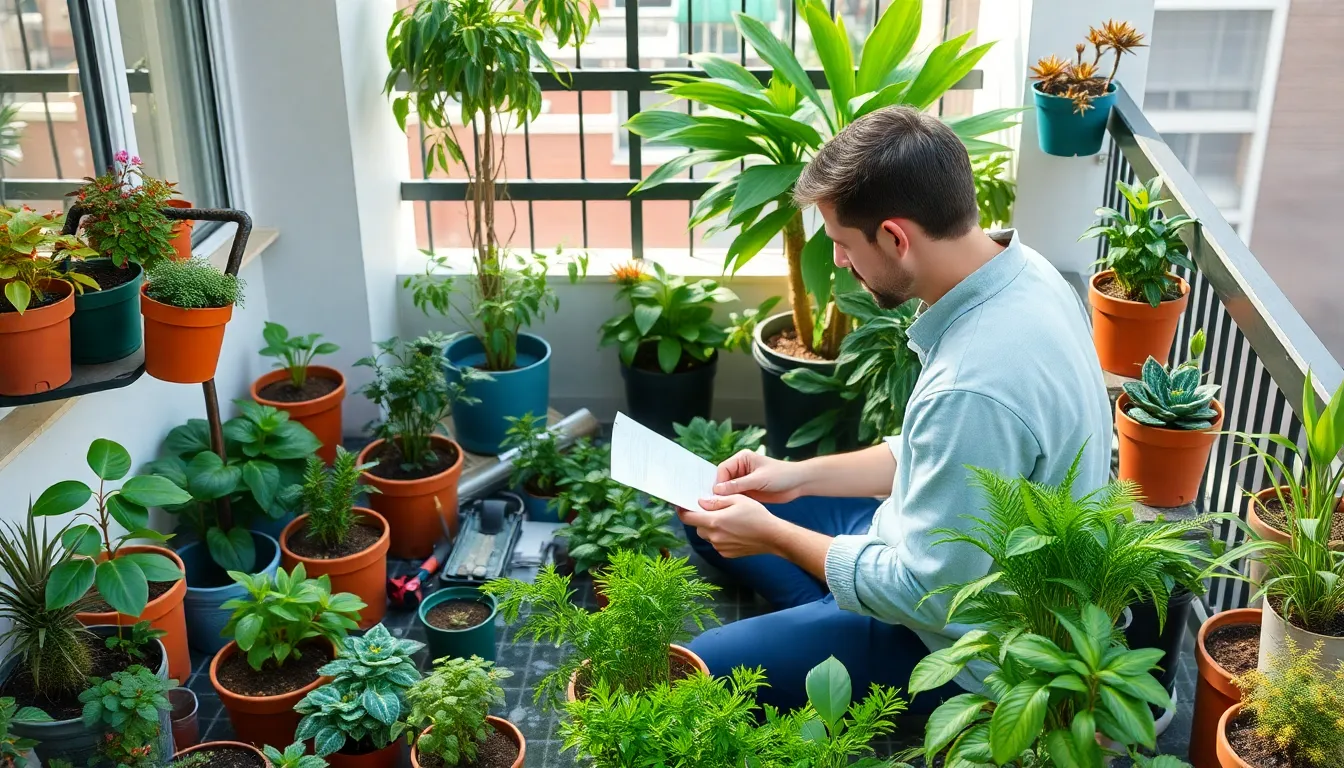
Strategic layout planning transforms your balcony into a thriving garden that maximizes every square inch. We’ll guide you through the essential steps to create an efficient growing space that works with your balcony’s unique characteristics.
Assess Sunlight Patterns Throughout the Day
Sunlight mapping becomes your foundation for successful balcony gardening. We recommend observing your balcony at different times throughout the day to identify which areas receive direct sunlight versus shade. Most plants require at least 4-6 hours of direct sunlight per day to thrive properly.
Morning sun areas work perfectly for herbs like basil and parsley that appreciate gentle light. Afternoon spots with intense sunlight suit heat-loving plants such as tomatoes, peppers, and succulents. Shadier corners accommodate ferns, begonias, and leafy greens that prefer filtered light conditions.
Document your findings by taking photos at 2-hour intervals from sunrise to sunset. This visual record helps you make informed decisions about plant placement and ensures each variety gets the light it needs to flourish.
Create Zones for Different Plant Types
Zoning your balcony garden creates organized growing areas that serve exact purposes. We suggest establishing distinct zones based on plant types and your gardening goals.
Ornamental Zone: Position flowering plants and decorative shrubs like dwarf olive trees in highly visible areas where they create visual impact. These plants serve as focal points and enhance your balcony’s aesthetic appeal.
Edible Zone: Dedicate space for herbs, vegetables, and fruits in containers suitable for smaller growing areas. Place these plants in easily accessible locations for regular harvesting and maintenance.
Utility Zone: Reserve a corner for gardening supplies, watering equipment, and tools. This organized approach keeps your balcony tidy while ensuring everything you need stays within reach.
Transition areas between zones can feature plants that serve dual purposes, such as flowering herbs that provide both beauty and culinary value.
Leave Walking Space for Maintenance
Maintenance accessibility determines the long-term success of your balcony garden. We emphasize creating adequate pathways between planters to ensure comfortable movement throughout your growing space.
Allow at least 18-24 inches of walking space between larger containers and plant groupings. This spacing prevents overcrowding while making it easier to water, prune, and harvest your plants regularly.
Consider the mature size of your plants when planning walkways, as some varieties will spread significantly as they grow. Adjustable plant stands and wheeled containers offer flexibility to modify your layout as your garden evolves.
Strategic placement of frequently tended plants near walkways reduces the need to reach over other containers, minimizing plant damage and making garden care more enjoyable.
Select Plants That Thrive in Container Gardens
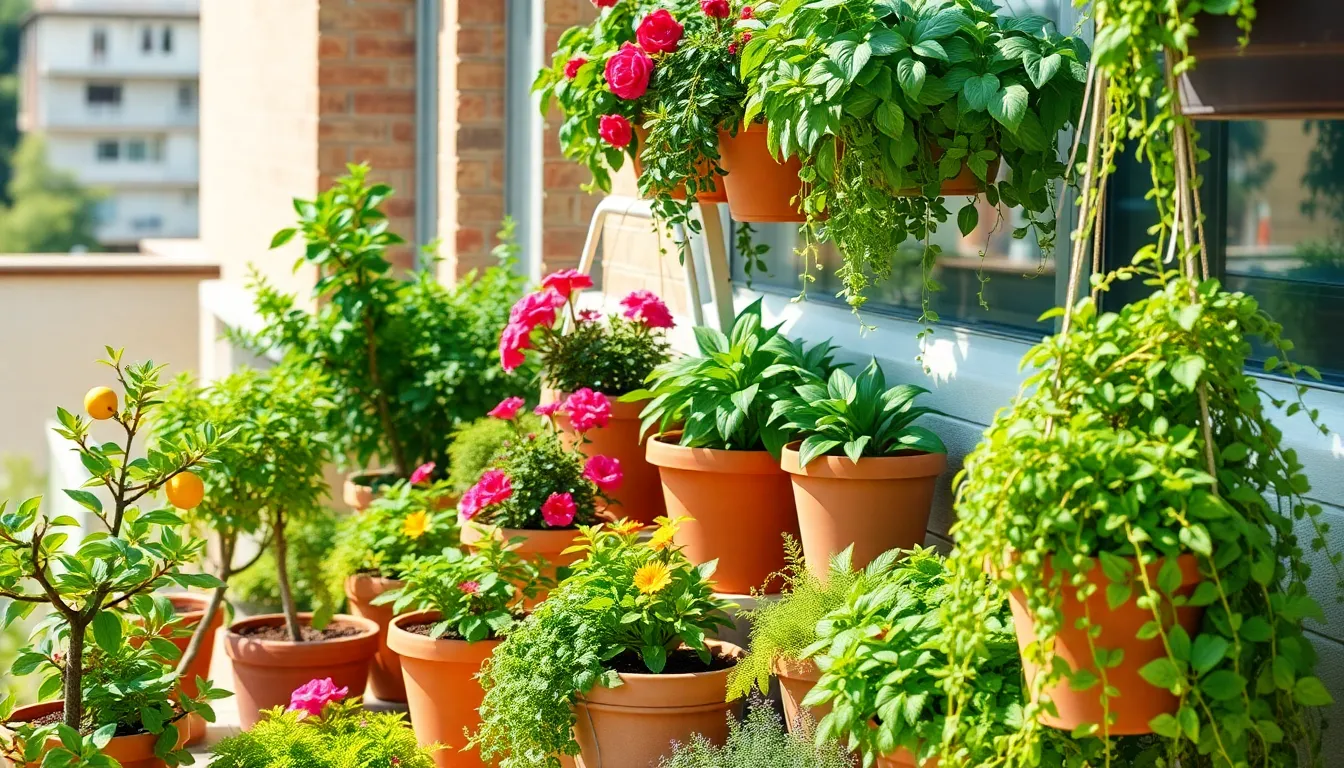
We’ve established our containers and layout, so now it’s time to choose plants that’ll flourish in our balcony environment. Container gardening requires exact plant varieties that can adapt to restricted root space and varying moisture levels.
Pick Compact Varieties for Small Spaces
Compact plant varieties are our best allies when working with limited balcony space. Dwarf fruit trees like miniature citrus or olive trees provide fresh produce without overwhelming our containers. Patio vegetables such as bush beans and compact tomatoes are specifically bred for container living and produce abundant harvests in small spaces.
Miniature roses add color and fragrance while staying manageable in size. Herbs like basil, mint, and rosemary grow well in smaller pots and provide fresh ingredients for our kitchen. Vertical gardening techniques using tiered planters or climbing plants on trellises help us maximize our growing area without cluttering the floor space.
Trailing plants in hanging baskets create visual interest at different heights while freeing up surface area for other containers. Succulents offer low-maintenance options that thrive in shallow containers and require minimal watering.
Choose Plants Based on Sun Exposure
Plant selection must match our balcony’s daily sunlight patterns for optimal growth. Full sun locations receive six or more hours of direct sunlight and support sun-loving herbs, vegetables, and flowers like marigolds or petunias. These plants typically produce more flowers and fruit when they receive adequate light exposure.
Shade-loving plants such as ferns, coleus, and certain begonias perform better on balconies with limited direct sunlight. Tropical houseplants like philodendron or spider plant adapt well to partially shaded balcony conditions and bring lush greenery to darker spaces.
Observing our balcony throughout different times of day helps us identify the best placement for each plant type. Morning sun areas work well for vegetables that need gentle light, while afternoon sun spots suit heat-tolerant flowers and herbs.
Consider Seasonal Growing Patterns
Seasonal planning ensures our balcony garden remains productive throughout the year. Cool-season vegetables like lettuce and spinach thrive in spring and fall temperatures, while warm-season crops such as tomatoes and peppers prefer summer heat.
Hardy plants that survive winter outdoors reduce our maintenance efforts and provide year-round structure. Perennials and small shrubs suited to our climate zone create a permanent foundation for our container garden. Annual flowers provide seasonal color changes and can be replanted each growing season for fresh variety.
Container-friendly annuals and perennials designed for shade or sun conditions give us flexibility in plant selection. Lightweight, stackable containers make it easier to move sensitive plants indoors during harsh weather and store empty pots during off-seasons.
Planning our plant rotation schedule maximizes our container usage and ensures continuous harvests throughout the growing season.
Install Vertical Growing Systems to Maximize Space
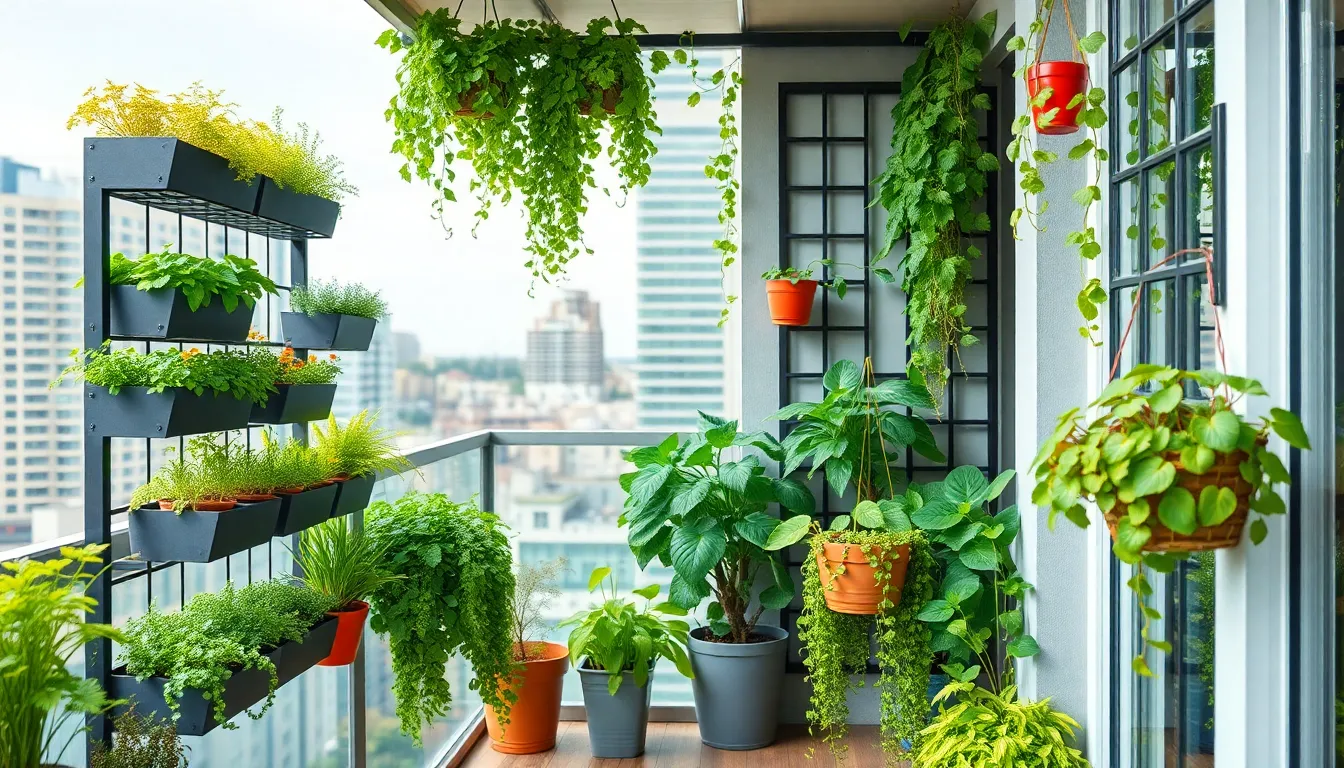
We’ll transform your balcony’s vertical space into a productive growing area using strategic vertical systems that stack plants efficiently. Plant stands with multiple tiers allow us to arrange containers at different heights while optimizing sunlight exposure for each level.
Set Up Wall-Mounted Planters
Wall-mounted planters free up valuable floor space while creating stunning living walls on your balcony. We can arrange these planters in panel systems or pocket configurations directly onto balcony walls. Herbs like mint, rosemary, thyme, chives, and parsley thrive exceptionally well in wall-mounted setups because they require minimal soil depth and have compact growth patterns. Pocket planters made from recycled shoe organizers or custom-built panels provide multiple growing compartments in a single vertical space. Installing these planters at eye level makes harvesting fresh herbs convenient during meal preparation.
Use Trellises for Climbing Plants
Trellises support climbing vegetables and fruits that naturally grow upward, making them perfect for vertical garden applications. We can train cucumbers, peas, and vine fruits along sturdy trellis structures to maximize our growing potential. Compact tomato varieties like ‘Tumbling Tom’ and miniature melons adapt well to trellis training systems. Installing trellises against balcony railings or walls creates additional growing space without consuming floor area. Choosing plants that climb naturally reduces the maintenance required while increasing our harvest yield per square foot.
Create Hanging Garden Displays
Hanging baskets and suspended planters use overhead balcony space that often goes unused in traditional gardening approaches. We can hang strawberries, small berry plants, and trailing herbs from balcony ceilings or overhead structures. Some vertical planter systems include built-in hanging bars specifically designed for suspended containers. Cascading plants in hanging displays create beautiful layered garden effects while maximizing our available growing space. Installing pulley systems makes watering and maintaining hanging gardens easier by allowing us to lower containers when needed.
Design a Functional Watering and Drainage System

Creating an efficient watering and drainage system keeps our balcony plants healthy while reducing daily maintenance demands. Proper water management prevents common container gardening problems like root rot and ensures consistent plant growth throughout the growing season.
Install Drip Irrigation for Easy Maintenance
Drip irrigation systems provide targeted, consistent watering that minimizes water waste and reduces our daily garden maintenance. Installing these systems on balconies delivers water directly to plant roots through small emitters, making them especially beneficial for container gardens where precise moisture control matters most.
Automated drip systems connect to timers for scheduled watering sessions, which proves ideal when we’re busy or away from home. Setting up these systems requires connecting main tubing to a water source, then running smaller tubes with emitters to each container. Timer controlled systems can water our plants multiple times daily with exact amounts, ensuring optimal moisture levels without overwatering.
Targeted emitters deliver water slowly and steadily, allowing soil to absorb moisture completely rather than creating runoff. This method supports plant health with minimal effort while conserving water compared to traditional watering methods like sprinklers or hand watering.
Ensure Proper Drainage to Prevent Root Rot
Drainage holes at the bottom of every container allow excess water to escape and prevent waterlogged soil conditions that lead to root rot. All pots must include these holes regardless of plant type, as standing water quickly damages root systems and kills plants.
Layering gravel, broken pottery, or mesh screens over drainage holes keeps soil in place while allowing water to flow freely. This barrier prevents soil from washing out during watering while maintaining proper drainage flow. Gravel works particularly well as it creates air pockets that improve drainage and root aeration.
Saucers or trays placed under pots catch runoff water, which we can reuse for watering or maintaining humidity levels for tropical plants. These collection systems prevent water damage to balcony surfaces while creating opportunities for water conservation. Collecting excess water reduces waste and provides a secondary water source during dry periods.
Consider Water Collection Methods
Rainwater collection maximizes our water resources by placing barrels or containers beneath downspouts to capture natural precipitation. This method provides free, naturally soft water that plants often prefer over treated tap water. Collected rainwater reduces our water bills while supporting sustainable gardening practices.
Trays positioned beneath multiple pots collect excess water for immediate reuse throughout our balcony garden. Strategic placement of these collection trays creates a water recycling system that reduces waste and maintains consistent moisture levels. Water collected this way contains dissolved nutrients from soil, making it particularly beneficial for plant growth.
| Feature | Purpose | Implementation Tips |
|---|---|---|
| Drip Irrigation | Consistent, efficient watering | Use timers, targeted emitters |
| Drainage Holes | Prevent root rot, waterlogging | Ensure every pot has holes |
| Water Collection | Conserve water, reduce runoff | Trays, barrels, downspout systems |
Create Privacy and Wind Protection
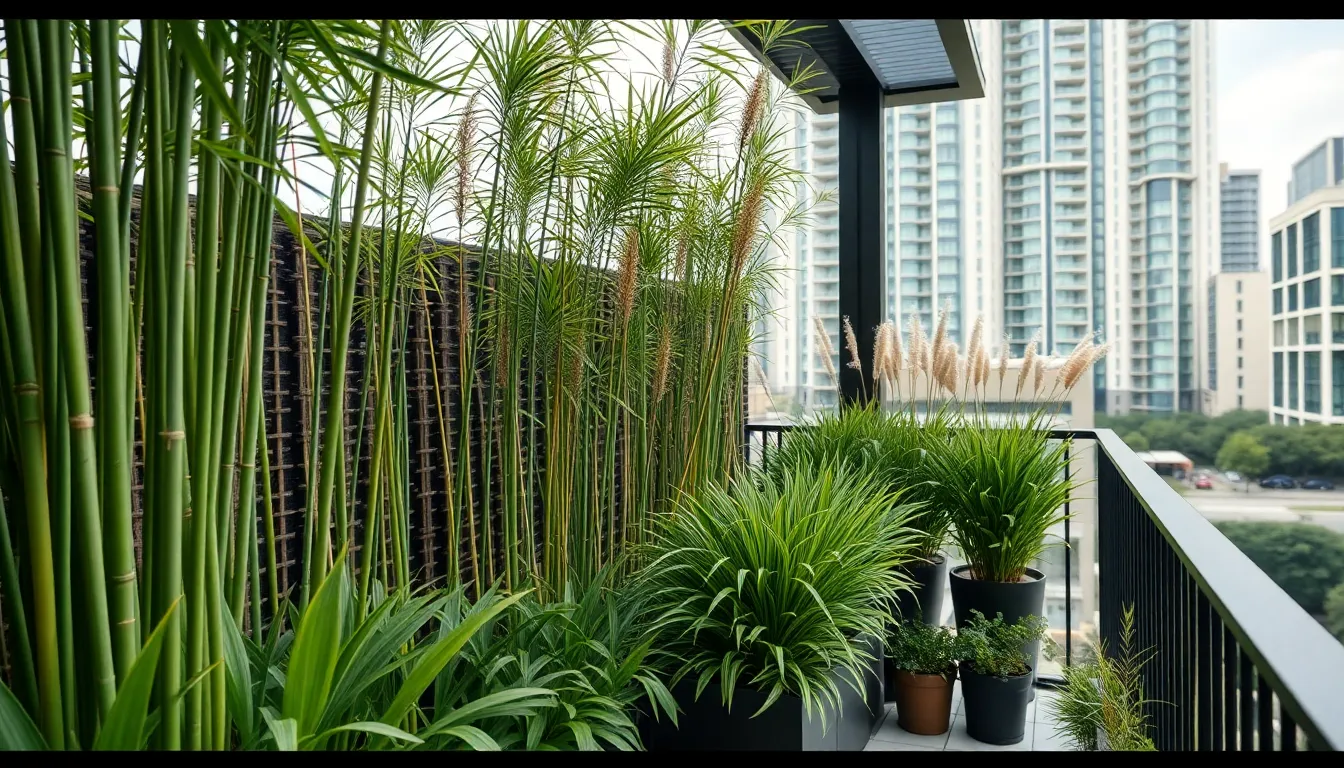
Creating effective privacy and wind protection transforms your balcony garden into a comfortable sanctuary. Wind barriers shield delicate plants while privacy screens establish your personal outdoor retreat.
Use Tall Plants as Natural Screens
Bamboo creates exceptional natural barriers that block wind while adding instant privacy to your balcony space. These fast-growing plants reach impressive heights and form dense screens that effectively buffer strong gusts. Ornamental grasses like fountain grass or feather reed grass offer another excellent screening option with graceful movement and seasonal texture changes.
Tall container plants serve dual purposes by filtering wind and creating visual barriers from neighboring balconies. We recommend positioning these natural screens along the windiest edges of your balcony where they’ll provide maximum protection. Strategic placement of tall plants also defines separate garden zones while maintaining airflow circulation throughout your space.
Install Wind Barriers for Delicate Plants
Polycarbonate panels create wind-resistant enclosures that protect vulnerable plants without blocking essential sunlight. These transparent barriers effectively shield tender seedlings and flowering plants from harsh gusts while maintaining visibility. Fabric privacy screens like the Patio Paradise Fabric Privacy Screen offer customizable wind protection with adjustable coverage options for varying weather conditions.
Strategic planter placement buffers wind effects around smaller plants by creating protective microclimates. Position larger containers upwind from delicate plants to deflect strong breezes and reduce stress on sensitive foliage. Trellises with climbing plants provide both structural wind protection and living barriers that strengthen over time as plants mature.
Add Decorative Elements for Style
Hanging planters create visual interest while adding protective layers of greenery throughout your balcony garden space. These elevated displays catch wind before it reaches ground-level plants while maximizing vertical growing opportunities. Decorative screens with built-in planters combine functionality and style by providing wind protection alongside attractive planting features.
Tiered planter arrangements establish natural wind breaks while creating stunning garden displays with varying heights and textures. We suggest incorporating decorative partitions that serve multiple purposes including storage, privacy, and plant support systems. Strategic placement of these stylish elements enhances both the protective qualities and aesthetic appeal of your balcony garden sanctuary.
Incorporate Multi-Functional Furniture and Storage
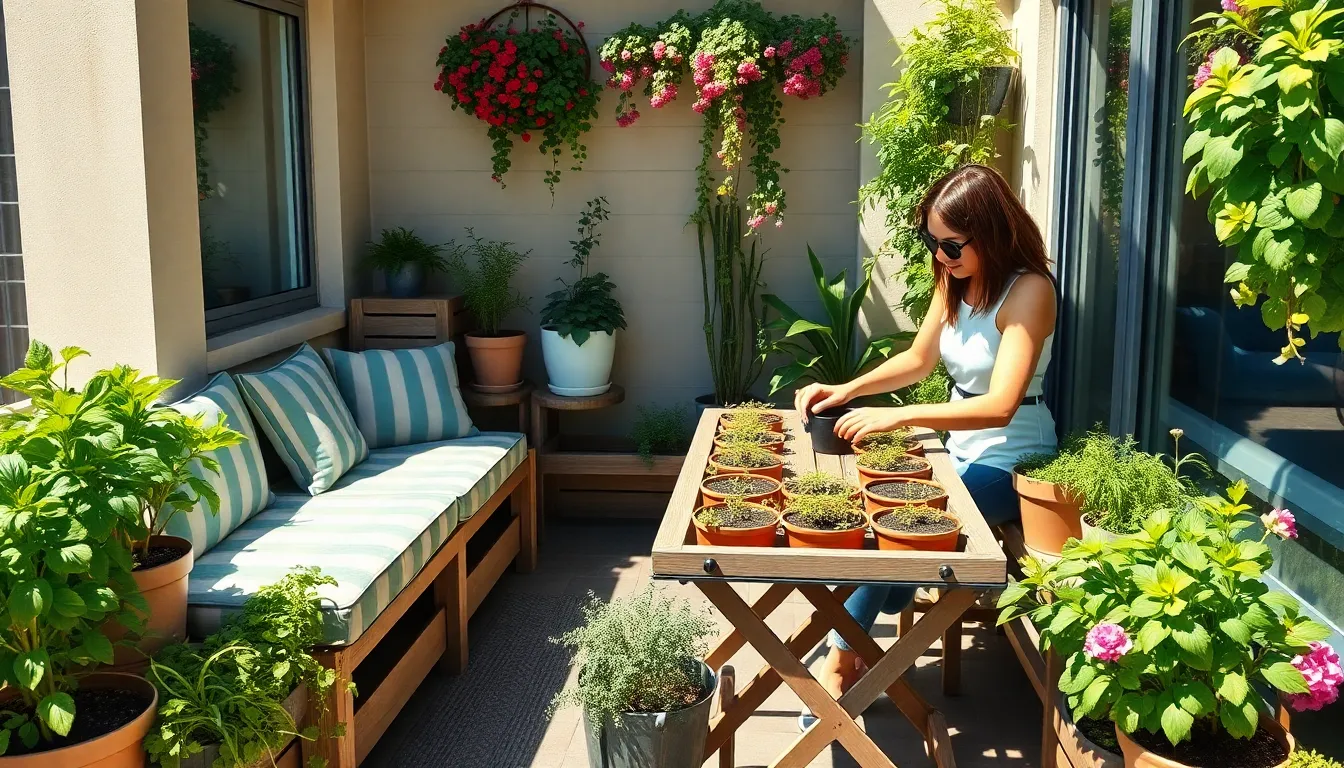
Smart furniture choices transform balcony gardens into organized spaces that maximize both growing potential and functionality. These pieces serve dual purposes by providing essential garden features while maintaining the comfort and usability of our outdoor sanctuary.
Choose Seating with Built-In Planters
Seating options with integrated planters create stunning focal points while maximizing our growing space. Garden benches featuring built-in planter boxes along their base allow us to cultivate herbs, small vegetables, or trailing flowers directly beneath our seating area. Chair designs incorporating side planters provide convenient spots for growing aromatic herbs like basil, mint, or thyme within arm’s reach during relaxation time.
Corner seating arrangements with wraparound planters work exceptionally well for L-shaped balconies, creating cozy nooks surrounded by greenery. These configurations allow us to grow a variety of plants at different heights, from tall ornamental grasses in back sections to cascading petunias or cherry tomatoes in front compartments.
Weight considerations become crucial when selecting planter seating, as soil and water add important load to our balcony structure. We recommend choosing lightweight materials like aluminum frames with fiberglass planter inserts, which provide durability without compromising safety.
Add Storage Benches for Garden Tools
Storage benches with hidden compartments keep gardening essentials organized while providing comfortable seating for tending to plants. These versatile pieces store hand trowels, pruning shears, watering equipment, and seed packets in weather-resistant compartments that protect tools from moisture and UV damage.
Cushioned storage answers offer the perfect combination of comfort and practicality, featuring removable tops that reveal spacious interior storage. We can store seasonal items like plant fertilizers, extra potting soil, or backup seeds while maintaining easy access during gardening activities.
Tool organization systems built into bench designs include dividers, hooks, and elastic straps that keep small implements sorted and prevent items from shifting during storage. This organization reduces time spent searching for exact tools and ensures everything stays in optimal condition between uses.
Include Folding Tables for Potting Work
Folding tables designed for potting work provide dedicated workspace that appears only when needed, conserving precious balcony real estate. These surfaces offer ample room for transplanting seedlings, mixing soil, and preparing containers without creating permanent clutter in our growing area.
Height adjustable features accommodate different tasks and user preferences, allowing us to work comfortably while standing or sitting. Tables with built-in soil trays contain mess during potting activities and feature drainage holes that direct excess water away from the balcony floor.
Compact storage capabilities make these tables ideal for small spaces, as they fold completely flat against walls or slide into narrow gaps between larger furniture pieces. Quick setup mechanisms allow us to deploy workspace in seconds when gardening tasks arise, then easily store the table when entertaining or relaxing outdoors.
Maintain Your Balcony Garden Year-Round

Successful balcony gardens require consistent care throughout all seasons to ensure plants remain healthy and productive. We’ll share essential maintenance strategies that keep your container garden thriving regardless of weather changes.
Establish Regular Watering Schedules
Consistent watering forms the foundation of balcony garden success since container plants dry out faster than ground plantings. Self-watering pots like AquaPots eliminate guesswork by providing steady moisture levels while preventing overwatering. These systems feature built-in reservoirs that automatically supply water as plants need it.
Water conservation becomes crucial when maintaining multiple containers on your balcony. Collecting overflow water with saucers under each pot allows you to reuse runoff for other plants. This method reduces waste while ensuring no water drips onto neighbors below.
Equipment selection makes watering routines more efficient and manageable. Lightweight watering cans work perfectly for small balcony spaces where maneuverability matters. Expandable garden hoses offer another solution by storing compactly when not in use while reaching every corner of your garden.
Timing your watering schedule prevents plant stress and water evaporation. Early morning watering gives plants time to absorb moisture before afternoon heat peaks. Evening watering works well too but avoid wetting leaves to prevent fungal diseases.
Carry out Seasonal Plant Rotation
Seasonal rotation maximizes your balcony’s growing potential by matching plants to optimal growing conditions throughout the year. Moving containers to different positions ensures each plant receives appropriate sunlight and temperature exposure as seasons change. This strategy prevents stunted growth and increases overall productivity.
Temperature fluctuations affect container plants more dramatically than ground gardens. Rotating heat-sensitive plants to shadier spots during summer protects them from scorching sun. Moving sun-loving plants to brighter locations during cooler months maintains their growth rates.
Planning seasonal transitions keeps your balcony garden productive year-round. Cool-season crops like lettuce and spinach thrive in spring and fall positions that receive morning sun. Warm-season vegetables like tomatoes and peppers need summer spots with maximum sun exposure.
Storage answers support effective plant rotation by providing temporary housing during transitions. Wheeled plant caddies make moving heavy containers effortless. Lightweight containers simplify the rotation process while reducing strain on your balcony structure.
Monitor for Pests and Diseases
Regular plant inspections catch problems early when treatments are most effective. Weekly checks of leaves, stems, and soil reveal signs of pest activity or disease development. Early detection prevents minor issues from becoming major garden disasters.
Visual symptoms guide your monitoring efforts toward common balcony garden problems. Yellow leaves often indicate overwatering or nutrient deficiencies. Small holes in leaves suggest insect damage that requires immediate attention.
Companion planting provides natural pest control without harmful chemicals. Planting marigolds with tomatoes repels aphids and whiteflies naturally. These flowering companions also attract beneficial insects that prey on garden pests.
Preventive measures reduce pest and disease pressure throughout the growing season. Proper spacing between containers improves air circulation and reduces humidity that encourages fungal growth. Removing dead plant material eliminates breeding grounds for harmful organisms.
Organic treatment options protect both your plants and the environment. Neem oil spray controls soft-bodied insects like aphids without harming beneficial pollinators. Diatomaceous earth sprinkled around containers creates barriers against crawling pests like slugs.
Conclusion
We’ve shown you that creating a stunning balcony garden isn’t just possible—it’s surprisingly achievable with the right approach. By combining smart container choices with strategic plant selection and innovative vertical answers you can transform even the smallest outdoor space into a thriving green sanctuary.
The key lies in maximizing every square inch through thoughtful planning and multi-functional elements. From drip irrigation systems to privacy screens and storage furniture each component works together to create an efficient and beautiful growing environment.
Your balcony garden journey starts with taking that first step. Whether you’re growing fresh herbs for your kitchen or creating a peaceful retreat from city life the techniques we’ve shared will help you build the outdoor oasis you’ve always wanted.
Frequently Asked Questions
What containers work best for balcony gardens?
Choose containers at least 12 inches deep for vegetables with proper drainage holes. Weather-resistant materials like fiberglass and resin are ideal for durability. Consider container weight for balcony safety and opt for vertical planters like pocket systems, tiered stands, and hanging containers to maximize growing space efficiently.
How do I plan my balcony layout for maximum growing space?
Observe sunlight patterns throughout the day to identify sunny and shaded areas. Create distinct zones for ornamental plants, edibles, and utility storage. Maintain 18-24 inches of walking space between planters for easy maintenance access. This strategic planning ensures optimal plant placement and functionality.
Which plants are best for small balcony containers?
Select compact varieties like dwarf fruit trees, patio vegetables, miniature roses, and herbs that adapt well to limited root space. Match plant selection to your balcony’s sunlight exposure and plan seasonally with cool-season and warm-season crops for continuous productivity year-round.
How can I maximize vertical growing space on my balcony?
Use multi-tiered plant stands, wall-mounted planters for living walls, and trellises for climbing plants. Implement hanging garden displays for trailing plants like strawberries and herbs. Consider pulley systems for easy maintenance of overhead planters to fully utilize all available vertical space.
What’s the best watering system for balcony gardens?
Install drip irrigation systems for consistent, targeted watering that minimizes waste. Ensure all containers have drainage holes and use layered materials for proper drainage. Place saucers to catch runoff for reuse and consider rainwater collection methods for sustainable water conservation practices.
How do I protect my balcony garden from wind and create privacy?
Use tall plants like bamboo and ornamental grasses as natural screens. Install wind barriers such as polycarbonate panels or fabric screens that protect plants while allowing sunlight. Strategic plant placement can define garden zones while maintaining proper airflow throughout your space.
What furniture works best for balcony gardens?
Choose multi-functional pieces like seating with built-in planters, storage benches for organizing tools, and folding tables for potting work. These space-saving solutions maximize functionality while maintaining aesthetic appeal, creating a comfortable and organized outdoor sanctuary that serves multiple purposes.
How do I maintain my balcony garden year-round?
Establish regular watering schedules using self-watering pots when possible. Rotate plants seasonally for optimal growing conditions and monitor regularly for pests and diseases. Use organic treatments and companion planting for natural pest control to ensure healthy, productive growth throughout all seasons.







